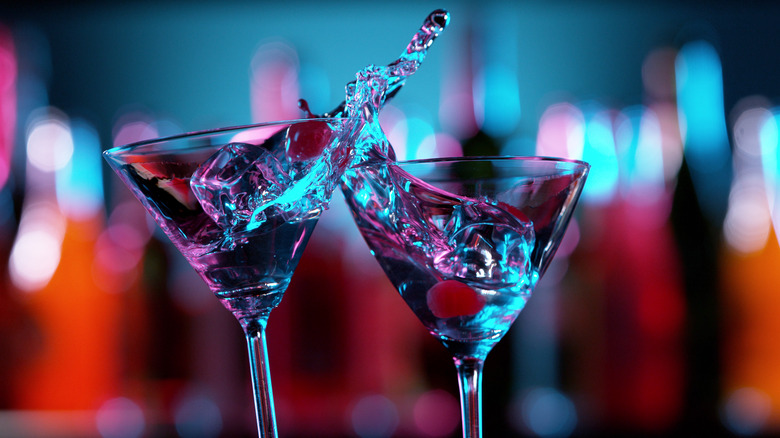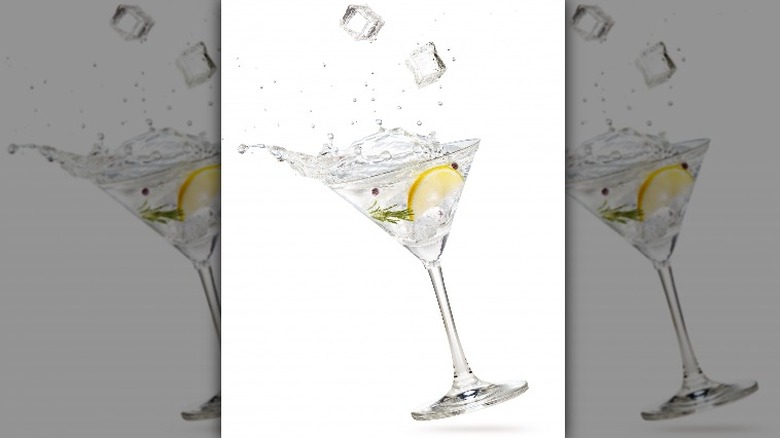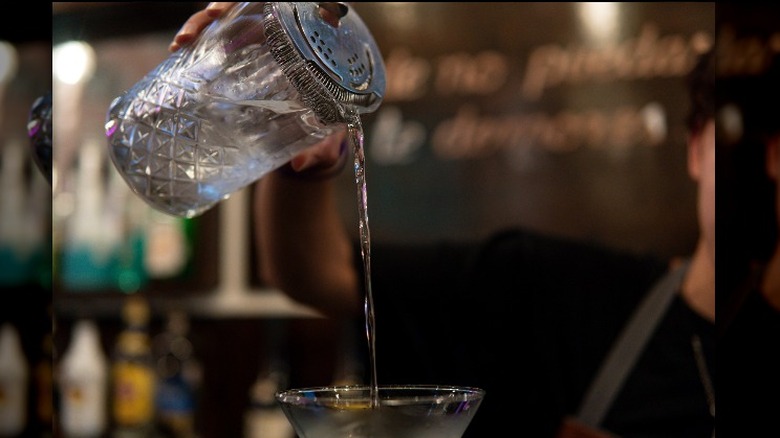Why You Shouldn't Use Just Any Ice For Your Martini
A martini is a simple combination of gin and vermouth — that's it. Different variations use sweet vermouth or dry gin; Some even throw in additional ingredients like orange or Angostura bitters. But, at its core, the martini is about as stripped-down a cocktail as they come. It's a two-ingredient drink with nothing to hide behind, but the wrong ice can ruin it. Primarily, ice cube shape, size, and water quality are the primary factors that constitute "good" ice. But, ice is just supposed to keep your drink cold, right? Does the ice you use in your cocktails really make that big of a difference? Believe it or not, the answer is "yes," especially in more delicate cocktails with basic ingredients and zero masking agents, like martinis.
Mixologist Morten Krag, via Fifty Pounds Gin, says ideal cocktail ice should provide a low, slow dilution that gives "the same experience from sip number one to the last." When assembling the nuanced martini, there's lots of room for ice and no room for error and you shouldn't use just any ice.
Shape up your ice
If you've ever dabbled in the mixology world, you've probably encountered the big cube-shaped ice blocks many bartenders favor. World-renowned cocktail giant Death & Co. sells a cube mold this size in collaboration with Wintersmith to help home mixologists achieve perfect ice; It makes four two-inch cubes that are clear. According to Wine Enthusiast, this size is called a "large cube," a "king cube," or an "Old Fashioned rock," and they provide nice, even dilution in on-the-rocks drinks. But, these big blocks don't serve the same function in a flouted martini glass. Ice size and shape make a difference, and what works for one cocktail doesn't always work for another.
That's where crushed ice comes in. Per Bon Appétit, NYC-based mixologist Audrey Saunders recommends holding a large ice cube in the palm of your hand and cracking it into smaller shards using the back of a spoon. To assemble, stir — don't shake. Shaking breaks up the ice and causes it to melt faster, which makes for a heavily diluted martini. Scientifically speaking, the ice itself doesn't keep your drink cold: the frigid water that slowly melts off of the ice cube as you sip is what keeps the drink chilled, explains Wine Enthusiast. According to the London Spirits Competition, the ice diluted from stirring and shaking can ultimately make up 15% to 20% of your total finished cocktail. To avoid over-diluting, Saunders recommends stirring the ice in your martini exactly 50 times, via Bon Appétit. (Yes, really.)
Don't skimp on water quality
Steven Robbins, general manager at Half Step bar in Austin, calls water quality "the starting point for all great drinks," via Punch. Thomas Waugh, head of bar operations at The Grill, the revamped Four Seasons restaurant, agrees. "Using good water is really important for me in making a good martini," says Waugh — and for good reason. Hard water is packed with magnesium, calcium, and sulfur, which can dramatically affect the flavor of your martini. Soft water, by contrast, is free from these minerals and lends a silkier mouthfeel.
Good ice keeps unwanted flavors and/or food odors from straying into your martini, explains Spirits Review. For slow-melting, flavorless, impurity-free ice, the outlet recommends using filtered, non-chlorinated water. Alternatively, you can avoid sub-par water quality altogether. Waugh pre-mixes, batches, and freezes his martinis, thereby making the ice built into the cocktails, explains Punch. But, at the end of the day, balance is the key to achieving a killer martini.
London Spirits Competition says temperature, water content, and ABV should coexist in perfect proportion for an ideal cocktail. Considering the average martini clocks in somewhere around 35% ABV, says Forbes, a little dilution could benefit your cocktail. But, too much water and poor water quality will surely stick out.


